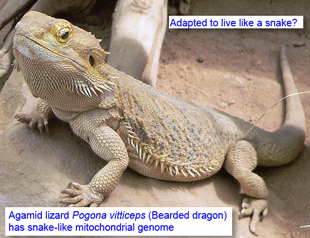Lizard mitochondria converge on snakes–why?
 In 2 june 2009 Proc Natl Acad Sci USA researchers from 5 American universities report on convergent molecular evolution among agamid lizards and snakes. In constructing a nuclear and mitochondrial DNA phylogeny of squamates (snakes and lizards), Castoe and colleagues noted their data placed agamid lizards as sister to snakes, rather than within lizard clade Iguania, as supported by prior work including morphology. The apparently aberrant phylogenetic placement was due to similarity among mitochondrial genomes of agamid lizards and snakes; nuclear genes recovered the established tree. Most of the aberrant signals were in first and second codon positions in protein-coding genes, and thus associated with similarity in predicted amino acid sequences among agamids and snakes. These convergent changes were distributed across all 13 mitochondrial protein-coding genes, but were clustered particularly in COXI and ND1.
In 2 june 2009 Proc Natl Acad Sci USA researchers from 5 American universities report on convergent molecular evolution among agamid lizards and snakes. In constructing a nuclear and mitochondrial DNA phylogeny of squamates (snakes and lizards), Castoe and colleagues noted their data placed agamid lizards as sister to snakes, rather than within lizard clade Iguania, as supported by prior work including morphology. The apparently aberrant phylogenetic placement was due to similarity among mitochondrial genomes of agamid lizards and snakes; nuclear genes recovered the established tree. Most of the aberrant signals were in first and second codon positions in protein-coding genes, and thus associated with similarity in predicted amino acid sequences among agamids and snakes. These convergent changes were distributed across all 13 mitochondrial protein-coding genes, but were clustered particularly in COXI and ND1.
The authors conclude that there was an ancient adaptive episode in the ancestors of today’s agamid lizards, which led to a snake-like mitochondrial genome. I note this conclusion is based on analyzing just 2 of the more than 350 species in 52 genera in Agamidae. Are these changes universal in Agamidae? There are 2 more complete agamid mitochondrial genomes in GenBank which could be examined; of additional interest would be to see if the same convergent changes are found in the 253 COI sequences from 88 agamid species in 11 genera in BOLD. As in this study, phylogenetic reconstruction usually involves just a few representatives of each lineage, which means that evolutionary patterns may remain invisible. I expect that BOLD will be an increasingly useful resource to expand the scope of phylogenetic studies utilizing mitochondrial DNA.
The conclusion that these findings represent convergent adaptive evolution is strong, yet it is also puzzling, as at first glance there doesn’t seem to be any special morphological or life-style resemblance between snakes and agamids as compared to other lizards. Perhaps we need to keep an open mind for other seemingly unlikely mechanisms, such as eukaryotic horizontal gene transfer.
This entry was posted on Tuesday, June 30th, 2009 at 11:45 am and is filed under General. You can follow any responses to this entry through the RSS 2.0 feed. Both comments and pings are currently closed.
June 30th, 2009 at 2:47 pm
Mark,
Thanks for the note and the writeup. It is great to get thoughtful feedback!
We definitely agree that more agamid mito genomes are highly motivated. Indications from our study were that a lot of convergent changes were ancestral to the two we looked at, but that some were on the terminal lineages. Parsing it out onto shorter branches would be great. If you (or anyone reading this) hear of any progress on this front, we would be grateful to know about it. The BOLD data would be good to look at as well, although it will be harder to know for sure if there are inconsistent phylogenies just within the COI fragment. Horizontal gene transfer was considered and ruled out as a mechanism for the data that we observed, by the way (the majority of sites in the mitochondrial genomes support the nuclear tree; only a small proportion of sites are responsible for disrupting the overall phylogeny), although obviously it is a mechanism that ought to be considered in any new case.
Cheers,
David